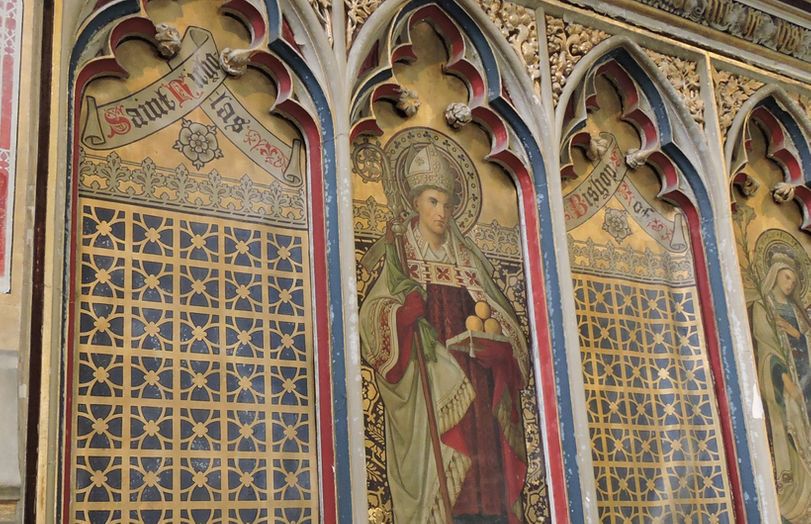Christmas learning resources
The patron saint of children, St Nicholas’ feast day is celebrated on 6th December, and in many parts of the world, he is seen as the traditional bringer of Christmas presents.
15 CCT churches or chapels are dedicated to St Nicholas and each one makes an appearance in the presentation. Images of the saint appear in paintings, carvings and stained glass windows.
Living in the 4th century, St Nicholas was a Greek who became bishop of Myra, a coastal city, in what is now Turkey. Stories of his life tell of his generosity and care for those in need, particularly children. He also has a connection with sailors and ships. St Nicholas typically appears as a bishop, wearing traditional vestments and a mitre on his head. In his hand is a crozier, the symbol of office carried by a bishop.
His symbol of three golden purses, balls or oranges is sometimes also shown, either carried by the saint or as a separate emblem. A second symbol associated with him is a ship.
It is perhaps for his secret giving of gifts and as the patron saint of children that St Nicholas has become most famous. It is especially what we remember about him at Christmas time.
One story tells of a poor man who had three daughters and no marriage dowries for them. St Nicholas, concealed by the darkness of night, threw a bag of gold through the open window, which landed in a stocking, hanging up to dry, in front of the fire. After the first daughter’s marriage, a second and third purse of gold coins mysteriously appeared, saving the girls from being sold into slavery.
Another story tells of three children seized by a villainous butcher, thrown into a wooden barrel, and intended to be sold as meat. St Nicholas challenged the butcher, saved the children and restored them to their families.
St Nicholas association’ with the protection of children and secret gift-giving continues to this day. So too does the custom of hanging up stockings by the fire.
Other stories tell of him calming waters at sea, saving sailors and ships from destruction during raging storms and gaining a special significance as a protector of sailors and merchants. Chapels dedicated to St Nicholas were built in ports and beside the sea. St Nicholas’ Chapel, in Kings Lynn, Norfolk was largely built when the town was a prosperous port with merchant ships sailing in and out of the harbour. Its spire can still be seen by fishing boats out at sea today.
Uphill, Somerset was once the site of the Roman port of Axium. The Old Church of St Nicholas sits prominently on a cliff overlooking the Bristol Channel and it is thought the outside was originally whitewashed making it clearly visible for navigation.
The learning pack is a ‘Pick and Mix’, allowing teachers to choose content depending on the time available and the needs of their class.
See an overview of the new St Nicholas resource here
To request the full resource pack as a file transfer email [email protected]

